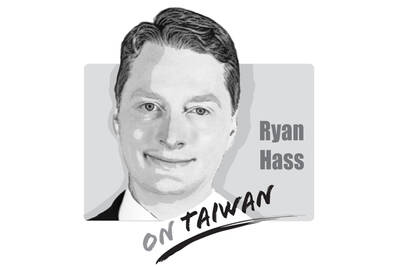Looking back at former president Lee Teng-hui’s (李登輝) “no haste, be patient” policy with regard to Taiwan’s cross-strait economic and trade relations, it was important at the time in terms of risk management and internal government controls. Even today, when dealing with China, Taiwan still cannot overlook the effects that any policy could have on national security, economic independence, the investment environment and social development — a consideration that was included in the “no haste” policy implemented in 1996 during Lee’s 12 years in power.
In the mid to late 1990s, the whole world was focused on the massive investment opportunities in China, and Taiwan was no exception, aiming to grab a sizeable share of the huge Chinese market. However, as opportunities are inevitably accompanied by risks, the government under Lee adopted the “no haste” policy to cap China-bound investments at US$50 million per project, ban the production of high-tech products in China and place restrictions on infrastructure sectors.
The policy received a lot of criticism from several business heavyweights at the time, including Formosa Plastics Group’s late founder, Wang Yung-ching (王永慶), and former Taiwan Semiconductor Manufacturing Co (TSMC) chairman Morris Chang (張忠謀).
The “no haste” policy certainly did not end capital outflows from Taiwan, and it also failed to effectively bar industries from making investments in China through indirect channels or relocating their assets there via a third country. Some political observers might also see it as a superficial measure, but it still set up some key thresholds so that the flow of funds across the Taiwan Strait would not excessively affect Taiwan’s overall economic and social development. In retrospect, the substitution of the “no haste” policy with former president Chen Shui-bian’s (陳水扁) “active opening and effective management” policy in 2001 led to even more investment pouring into China.
This year, the COVID-19 outbreak left China’s economic activities stagnating for three to four months due to factory shutdowns, production suspensions and city lockdowns. As China remains the largest offshore production base for Taiwanese manufacturers, it is difficult to imagine how Taiwan’s economy would fare today if all of the nation’s major industries had relocated and set up factories in China 24 years ago without the restrictions set by the “no haste” policy.
The outbreak has also revealed the deficiencies in the crisis management capabilities of the Chinese government, which proves that a certain level of economic control in specific areas regarding the development of trade relations with China is needed. Regarding cross-strait economic exchanges, it was righ to promote the “no haste” policy two decades ago and remains so today, considering the deteriorating trade relations between the US and China, and Beijing’s geopolitical ambitions.
Whether it is Lee’s “no haste” policy or President Tsai Ing-wen’s (蔡英文) “New Southbound Policy,” people must be reminded not to put all their eggs in the China basket to prevent Taiwan from becoming over-reliant on its giant, unstable neighbor. If there was no “no haste” policy, TSMC and many other semiconductor firms might have invested heavily in China, and Taiwan would have lost its “silicon shield.” In the past, people had different opinions about the necessity of the “no haste” policy, but looking back at it today, more people are feeling differently, including those who criticized it strongly.

There are moments in history when America has turned its back on its principles and withdrawn from past commitments in service of higher goals. For example, US-Soviet Cold War competition compelled America to make a range of deals with unsavory and undemocratic figures across Latin America and Africa in service of geostrategic aims. The United States overlooked mass atrocities against the Bengali population in modern-day Bangladesh in the early 1970s in service of its tilt toward Pakistan, a relationship the Nixon administration deemed critical to its larger aims in developing relations with China. Then, of course, America switched diplomatic recognition
The international women’s soccer match between Taiwan and New Zealand at the Kaohsiung Nanzih Football Stadium, scheduled for Tuesday last week, was canceled at the last minute amid safety concerns over poor field conditions raised by the visiting team. The Football Ferns, as New Zealand’s women’s soccer team are known, had arrived in Taiwan one week earlier to prepare and soon raised their concerns. Efforts were made to improve the field, but the replacement patches of grass could not grow fast enough. The Football Ferns canceled the closed-door training match and then days later, the main event against Team Taiwan. The safety
The National Immigration Agency on Tuesday said it had notified some naturalized citizens from China that they still had to renounce their People’s Republic of China (PRC) citizenship. They must provide proof that they have canceled their household registration in China within three months of the receipt of the notice. If they do not, the agency said it would cancel their household registration in Taiwan. Chinese are required to give up their PRC citizenship and household registration to become Republic of China (ROC) nationals, Mainland Affairs Council Minister Chiu Chui-cheng (邱垂正) said. He was referring to Article 9-1 of the Act
Strategic thinker Carl von Clausewitz has said that “war is politics by other means,” while investment guru Warren Buffett has said that “tariffs are an act of war.” Both aphorisms apply to China, which has long been engaged in a multifront political, economic and informational war against the US and the rest of the West. Kinetically also, China has launched the early stages of actual global conflict with its threats and aggressive moves against Taiwan, the Philippines and Japan, and its support for North Korea’s reckless actions against South Korea that could reignite the Korean War. Former US presidents Barack Obama